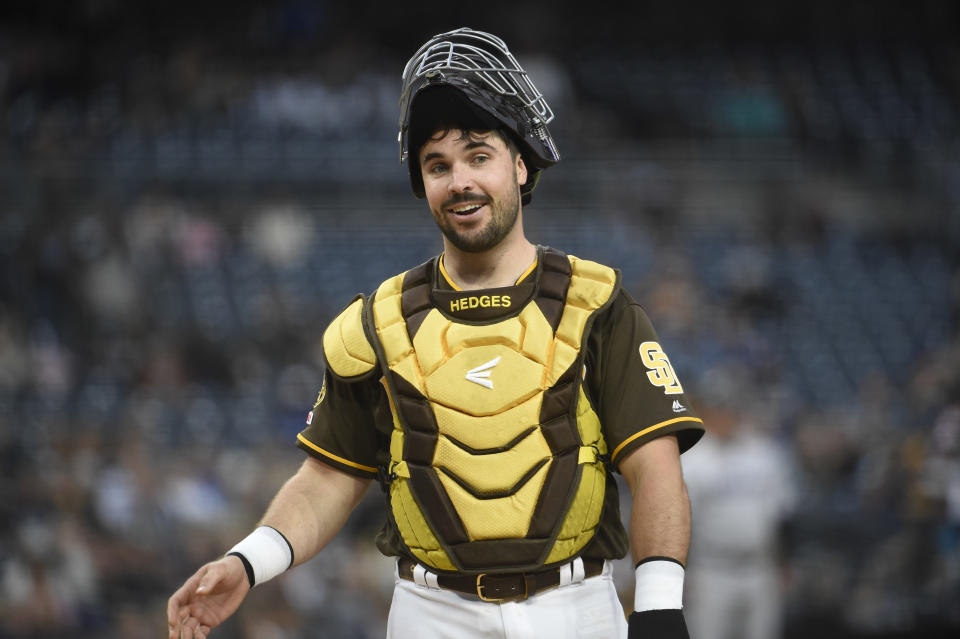Inside the craft of the best pitch framer in MLB
LOS ANGELES — Austin Hedges sits up in his seat and puts out his left hand, as if holding a catcher’s mitt. Baseball’s best pitch framer is explaining how to receive a low pitch, which he says is the most challenging to catch correctly. His eyes open wide. A stern yet excited inflection consumes his voice.
Framing a pitch is a fine art, and the San Diego Padres catcher takes pride in explaining his work.
“Well a lot of guys will turn their thumb over,” Hedges says while turning his thumb toward the floor of the visiting clubhouse in Dodger Stadium. “That's probably a stronger position to be in, but it looks less a strike in my opinion because if your glove is down, this is the highest pitch the umpire sees.”
He points to the bottom of his palm, which is atop his left hand’s backhanded position.
“If your glove is up,” Hedges continues, rotating his hand about 90 degrees, so his thumb is parallel to the ground, “this is the highest pitch the umpire sees.”
Now, he points to the top of his laterally facing pinkie finger. He shows the several inch difference with his fingers.
“So we're talking a baseball and a half more glove in the strike zone,” he says.

Those few inches are the difference between him playing for the Padres for five seasons and never making the big leagues. He’s a career .206 hitter. But through the first half of 2019, Hedges is catching more strikes on average than anyone in MLB. The 26-year-old currently leads all catchers with 13 runs saved, per Statcast advanced metrics. The next closest catcher has eight.
In simple terms, at least until his bat comes around, Hedges is a defensive specialist. He knows that, and he’s aware of how much he can influence the game, and how those numbers translate to positive advanced metrics.
“It's the way I can impact the game the most just because I have the most opportunities to,” Hedges says.
How Austin Hedges fell in love with fielding
He loves fielding more than most and it traces back to middle school when he started training with Brett Kay, a former minor league catcher who’d coach Hedges through high school. Kay realized quickly that Hedges was more fine-tuned than other aspiring backstoppers, and began teaching him at a more advanced pace.
Kay refers to his coaching points as the big three: blocking, receiving and throwing. They combine to create a complete catcher. But the plays that make highlights — throwing out runners or stopping wild pitches — won’t impact the game as much. Take this season for example, Hedges has thrown to second or third base a total of 16 times. Meanwhile, he’s caught just over 500 innings.
“We were doing analytics before we knew what we were doing from an analytical standpoint,” Kay said, “you know, stealing pitches, making them look like strikes.”
Hedges learned to receive pitches with soft hands through drills with Kay. A few feet apart, Kay threw tennis balls at a kneeling Hedges. As Hedges swiftly grabbed and released the ball with his left hand, another ball came. Then another. And another. He once caught 191 balls in a row, which is still a drill record, Kay said.
Hedges refers to the drills as “failure drills,” or drills you’re not supposed to be good at. He still does them on a regular basis. Some are as simple as the tennis ball drill but instead of catching with the whole hand, he uses just a thumb and finger, rotating through fingers on each repetition. Others are more complicated, like the drill he invented a few springs ago.
Similar to a version of modified wall ball, Hedges waits in a crouch in front of a wall. From behind Hedges, someone bounces a tennis ball off the wall. It’d be challenging enough not knowing where the ball will land. But Hedges adds a twist. He wears Nike strobe glasses which blur eyesight, similar to the impairment goggles police use to simulate drunk driving.
“The harder you challenge yourself, the easier it is to put yourself in a position and catch a guy throwing 95 miles per hour,” Hedges says.
Hedges always wants to catch the bottom of the baseball. While the location of the ball is constantly changing, he can improve his odds through anticipating. It starts with a target so the pitcher isn’t throwing to his body. The location of his glove is in part based on the pitch and in part on the film he’s watched of opposing hitters.

When he’s observing those hitters, he can’t help but notice the catchers too and how their actions impact the game. Though catching can often look simple, not all of it is set mechanics.
That’s why sometimes Hedges drops his left knee in the dirt but other times he doesn’t.
The stance makes it easier to receive pitches since his knee won’t interfere with his mitt, but works best against right-handed hitters. When the hitter’s left-handed, Hedges doesn’t like having his left knee down because the angle he’s positioned himself in won’t properly present the pitch.
“I try to anticipate where's the hardest that this is going to be to catch to make it still look like a strike and I just try to anticipate it right there,” Hedges says. “If I'm ready for that pitch, if it's even more of a strike or an even easier pitch to catch, I'm going to catch it just fine.”
Like most art, it’s all preference, a morphing of tidbits from other players and parts of the game. But that doesn’t mean there aren't some universal truths.
Hedges won’t turn his thumb down. Even if it’s sometimes a stronger position, it’s not worth it. Receiving is about framing and he can’t sacrifice an opportunity for a strike.
“It doesn't make sense,” Hedges says. “ It just doesn’t look good in my opinion.”
More from Yahoo Sports:


